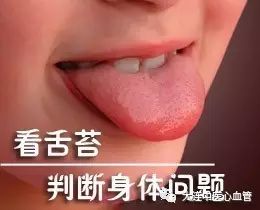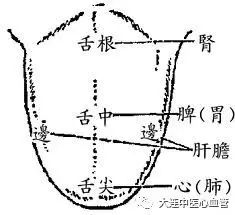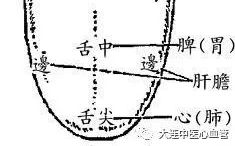
“A normal person’s tongue is soft and flexible, with a light red color, full of vitality. The surface of the tongue is covered with a thin layer of tongue coating, which is white, with appropriate moisture. The blood vessels on the underside of the tongue are of moderate thickness and smooth, not exceeding half the length of the tongue base.” In Traditional Chinese Medicine (TCM), the tongue is divided into the tongue tip, middle, root, and sides. TCM believes that the tongue tip corresponds to the heart and lungs, the middle to the spleen and stomach, the root to the kidneys, and the sides to the liver and gallbladder. Observing the tongue should focus on several aspects: tongue body, tongue coating, tongue papillae, and the blood vessels and meridians on the tongue’s underside. The tongue body includes the size, shape, color, thickness, softness, and surface cracks; the tongue coating includes color, moisture, thickness, and whether there are patches; the blood vessels on the tongue’s underside are observed for length and thickness; the tongue papillae are assessed for size and color.
“When observing the tongue, it is essential to be calm and composed, preferably in sufficient natural light.” First, face the light so that it can shine directly into the mouth, avoiding any interference with the recognition of the tongue body and coating colors. It is important to extend the tongue slowly and not too quickly or tensely, placing it near the lips and trying to relax. The shape of the tongue when extended is also part of the observation.
Common Condition 1: “Qi Deficiency with Damp-Heat”
Qi deficiency refers to a series of pathological changes caused by insufficient vital energy, related to the intense social competition, excessive stress, and unhealthy lifestyles of modern people. Especially in summer, when the weather is hot, excessive internal heat can easily lead to damp-heat.
Appearance of the tongue:
The tongue is swollen, weak, with teeth marks on the edges, the overall tongue body is pale white and lacks redness, the tongue coating is greasy and white, and in severe cases, it may turn yellow, with a thick coating adhering to the entire tongue surface.
Regulation methods:
1. Five-finger peach chicken soup. It is delicious, aromatic, and nutritious, providing excellent health benefits.
2. Job’s tears powder soaked in milk. Job’s tears (Coix lacryma-jobi) can prevent cancer and nourish the skin; it can be lightly roasted, ground into powder, and soaked in milk.
3. Yam and Job’s tears tea. Boil three qian (approximately 9 grams) each of Huai yam (Dioscorea opposita) and Job’s tears in water to drink. This can restore and replenish vital energy, invigorate the spirit, and improve complexion.
Common Condition 2: “Yin Deficiency”
Yin deficiency refers to the insufficiency of the body’s essence, blood, and body fluids. Since essence, blood, and body fluids are all classified as Yin, it is termed “Yin deficiency,” commonly seen in patients with prolonged illness or after febrile diseases that lead to the consumption of Yin fluids.
Dr. Chen Rundong from the Guangdong Provincial Hospital of Traditional Chinese Medicine states that due to Yin deficiency failing to control fire, excessive fire can further damage Yin fluids, and the two often influence each other.
Appearance of the tongue:
The tongue is red, tender, with a smooth surface lacking moisture, and may have little or no coating, appearing quite dry. Regardless of the disease, any tongue appearance of this nature indicates the internal consumption of Yin fluids, with severe depletion of body fluids. A smooth, red tongue indicates excessive heat damaging Yin, while a smooth, pale tongue indicates both Qi and Yin deficiency.
Regulation methods:
1. Lily and Ophiopogon soup. Lily (Lilium brownii) moistens the lungs and reduces Qi, while Ophiopogon (Ophiopogon japonicus) nourishes Yin and the stomach; both herbs can moisten dryness and restrain fire.
2. Soft-shelled turtle and Dendrobium soup. Both Dendrobium (Dendrobium candidum) and soft-shelled turtle are effective for nourishing Yin deficiency; boiling them together can clear Yin fire and replenish Yin deficiency.
Common Condition 3: “Qi Stagnation and Blood Stasis with Liver Fire”
Individuals with blood stasis have slower blood flow, and in some areas, blood flow may even come to a complete standstill, which is more common in older individuals.
This constitution is also very common among young women, who often experience irregular menstruation, dark menstrual blood, and symptoms of blood stasis such as clots and dysmenorrhea. Additionally, emotional distress can also lead to blood stasis.
Appearance of the tongue:
The tongue body is relatively thin, with red edges, a yellow coating, and the tongue papillae are coarse and dry. If it develops into excessive liver fire, the tongue body may appear dark, with purple-black spots or points, and the blood vessels on the underside of the tongue may become thickened and distorted.
Regulation methods:
1. Drink more floral teas, such as rose tea, peppermint tea, and jasmine tea. These can regulate menstruation, invigorate blood, and nourish Qi.
2. Increase physical activity to promote blood circulation, reduce stress, and relax the mind.
Common Condition 4: “Blood Deficiency”
Blood deficiency is characterized by a state of insufficient blood in the body. Blood circulates through the vessels, nourishing and moistening all organs and tissues, maintaining normal physiological activities. If blood is deficient, its nourishing and moistening effects will weaken, leading to insufficient spirit, fatigue, and a pale complexion.
Due to blood loss during menstruation, blood deficiency is more common in women.
Appearance of the tongue:
The most notable feature is a pale white tongue.
Regulation methods:
1. Angelica and ginger lamb soup, which has warming properties and can dispel cold and alleviate fatigue.
2. Eat more red dates, which can nourish blood and improve complexion.

Beginner Level
Basic Knowledge of Tongue Diagnosis
A. Method of extending the tongue
Extending the tongue also requires skill; it should be done in sufficient light, with the tongue naturally extended, relaxed, flat, and the tip slightly downward, with the mouth opened wide (but not excessively forcefully) to fully expose the tongue. Avoid scraping the tongue coating easily, as this can obscure the true appearance of the tongue coating.
B. What to observe on the tongue
Observing the tongue follows a sequence: generally, observe the tongue tip first, then the middle, sides, and finally the root, while also examining the color and quality of the tongue body (tongue quality) and the thickness and color of the tongue coating.
C. What does a normal tongue look like
A normal tongue can be summarized in six words: “light red tongue with thin white coating.” Specifically, the tongue color is light red and bright, the tongue quality is moist, the tongue body is of moderate size, soft and flexible, and the tongue coating is even, thin, white, and moist.
D. What are tongue coating and tongue quality
Observing the tongue coating: the tongue coating refers to a thin layer of residue covering the tongue surface, which is normally formed by stomach Qi; thus, healthy individuals often have a thin white coating.
The tongue quality includes the size, shape, color, thickness, softness, and surface cracks of the tongue.
Advanced Level
Identifying minor issues and nurturing small ailments
Red tip and yellow coating
If you notice a red complexion, dry throat, a preference for cold drinks, mouth ulcers, and irritability, your symptoms indicate “Yin deficiency with excessive fire” and hyperactivity of heart fire. You should maintain humidity in the indoor air, avoid spicy and greasy foods, and regularly drink teas made from Ophiopogon, South flower, and Platycodon. For severe throat pain, you can add honeysuckle. You can also use bloodletting methods on the back or ear tips to clear heat. Alternatively, rub the palms and soles. If you have bad breath, eat easily digestible foods like vegetables and fruits, and avoid greasy and fried foods, ideally abstaining from alcohol and smoking.
Pale tongue and white coating
If you experience cold sensitivity, body aches, no sweating, nasal congestion, clear nasal discharge, itchy throat, and cough with white, thin phlegm, this indicates a “wind-cold cold” as described in TCM, where external wind-cold causes pore closure; sweating to dispel cold is necessary.
Tongue with cracks
If your tongue has no coating and shows many “cracks” on the surface, and there is no discomfort, this is physiological and does not require treatment. However, if cracks appear after a severe illness, with a red tongue and no coating, and discomfort is present, this indicates Yin deficiency and requires medication.
Map-like tongue coating
If you notice that some areas of your tongue have a thin coating while others are smooth and without coating, forming irregular patches resembling a map, this is called “geographic tongue.” However, do not panic; if you have no discomfort, no treatment is necessary, as it is a physiological phenomenon. If you have chronic stomach issues or other chronic diseases and have never experienced this before, the appearance of a “geographic tongue” may indicate Yin deficiency; while treating the underlying disease, you can drink American ginseng tea (9 grams daily, brewed with boiling water, consumed frequently) to promote self-healing.
Teeth marks on the tongue edges
If you notice a swollen tongue with a thin white coating and teeth marks on the edges, this may indicate relative insufficiency of the spleen and stomach’s transport function, leading to difficulties in food digestion and absorption. Reduce consumption of greasy and hard-to-digest foods, increase intake of vegetables, fruits, and light foods, and engage in appropriate exercise. If you also experience a pale complexion, cold sensitivity, cold limbs, fatigue, lower back pain, loose stools, frequent bowel movements, and lower limb swelling, this may indicate spleen and kidney Yang deficiency. First, pay attention to warmth, and regularly prepare chicken soup or bone broth, adding yam, goji berries, and daylily for better results.
Black and greasy tongue coating
A black tongue coating may indicate a severe condition. If the tongue coating is black but the edges and tip are normal light red, and there are no other obvious discomforts, this may be a “staining” phenomenon. You may have consumed colored foods or taken certain medications; sometimes, antibiotics can also cause black coating. These situations are not pathological and do not require concern. However, patients with severe stomach issues should be cautious; if the edges and tip of the tongue are deep red or even purple, this indicates worsening conditions, and medical attention should be sought.
Observing family members’ tongues
If a baby has a thick white coating on the tongue, it often indicates irregular eating or digestive issues. At this time, you can give the child traditional Chinese medicine such as Xiaoer Huashi Wan, Xiaoer Qipai Wan, or Huoxiang Zhengqi Wan to stimulate appetite.
For middle-aged and elderly individuals, especially overweight parents, if the root of the tongue feels numb and the index and middle fingers feel stiff, this may be a precursor to a stroke caused by cerebral ischemia. In such cases, it is essential to take the elderly to the hospital promptly.
Patients with hypertension or hemorrhoids often have yellow and dry tongue coatings, accompanied by constipation. At this time, they should take some laxatives, such as Ma Ren Run Chang Wan, or use senna leaves soaked in water as tea to maintain smooth bowel movements.
In the later stages of a cold or fever, a tongue with little coating and a deep red color indicates heat evil damaging Yin; at this time, some Yin-nourishing and heat-clearing Chinese herbs can be used for regulation.
For women in menopause, if there are many blood stasis points on the sides of the tongue, accompanied by irritability, this indicates endocrine and metabolic disorders leading to pigment deposition. In this case, some liver-soothing and Qi-regulating Chinese herbs, such as Shugan Wan and Xiaoyao Wan, can be taken for quicker results.

